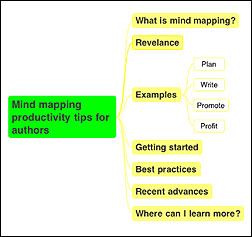Guest Expert: Roger C. Parker
Mind mapping is a technique that visually displays ideas, and their relationships to each other. Authors can create mind maps by hand, on paper, or use one of the hundreds of computer software programs available.

Mind mapping is important for authors because getting started is the hardest part of any writing project. Getting started, generating ideas and organizing them in the proper order and relationship to each other, is the first step beyond intention and commitment. This is when procrastination often sets in, regardless of the size of a project.
Once a mind map has been created, however, showing the structure of an article, book, or presentation, the rest is easy…consisting mainly of filling in the blanks, providing the words, sentences, and paragraphs needed to develop the main ideas identified in the mind map.
Above is the mind map I created to jumpstart this blog post. Notice that I can see, at a glance, the ideas I want to discuss and the order I’m going to discuss them.
Planning is the hardest part of any project. Once the structure of a project has been identified, the rest is simply doing it!
Mind maps for authors
Mind mapping plays a role at each of the four steps in every author’s writing and publishing journey:
• Step 1: Planning. Mind maps help authors identify their writing and publishing goals, their ideal readers, their reader’s information needs, and the competition. Mind map-based planning helps authors position their book and look ahead to how they want to profit from their book.
• Step 2: Writing. Writing without a content plan is like driving from Boston to Los Angles without a road map—it can be done, but it’s highly inefficient. Time spent creating a writing plan is more than offset by the time saved writing a book. Mind maps at the writing stage also help you explore ways to get your book written sooner and make it easy way to track your writing progress.
• Step 3: Promoting. Books don’t sell themselves. Authors have to promote their books while they’re writing them….and for a long time afterward. Mind maps make it easy to coordinate, or create a synergy, between the content of their book and their ongoing social media marketing. Mind maps make it easy to evaluate their author platform, create a social media action plan, and prepare for the launch of their book.
• Step 4: Profiting. In most cases, author profits from book sales are not enough; from the beginning, authors must know how they’re going to leverage their book into income from products, services, and speaking. Books are businesses; mind maps make it easy to develop and implement a “big picture” view of their future profits.
Getting started
One of the best ways to get started in mind mapping is by hand, with a sketch showing the title of your article, blog post, or book in the center, surrounded by circles containing the main ideas you want to cover in your book. A great place to start is Dan Roam’s The Back of the Napkin: Solving Problems and Selling Ideas with Pictures and its follow-up, Unfolding the Napkin: The Hands-On Method for Solving Complex Problems with Simple Pictures.
Another inspiring introduction to visual thinking and mind mapping is Sunni Brown’s The Doodle Revolution blog and website.
If you’re interested in exploring mind mapping software, the easiest way to get started is to do an online search for mind mapping software. This will bring up hundreds of options, for all computing platforms, including Macintosh and Windows-based computers, iPhones, and iPads. Most mind mapping software programs offer free trial downloads. My example, above, was created with Mindjet’s MindManager for the iPad.
Best practices
Here are some suggestions based on ten years of experience using mind mapping software for everything from planning articles, blog posts, books, ebooks, to e-courses and weekly teleseminars:
• Be concise. Keep your mind maps simple by using keywords and short phrases to place the emphasis on the structure of your mind maps.
• “Drag and drop” rather than copy and paste. When you want to reposition a topic, simply click on it and—holding down the mouse button–drag it to the desired location. This is much faster than using the mouse to select, open menus, and copy and paste.
• View options. Get in the habit of collapsing and expanding topics. This will help you focus on the structure of your project. When you expand a topic, like “Examples” in the above map, you see the Plan, Write, Promote, and Profit subtopics. If I collapsed the Examples, the Plan, Write, Promote, and Profit subtopics would disappear.
• Use Notes. Familiarize yourself with the Notes feature included with most mind mapping software features. Use notes, attached to any map topic or subtopic, when you want to jot down a sentence, or more, developing your ideas. Your notes won’t clutter up your map, but will be there when you need them.
• Export. The key advantage of mind mapping software is that you can export your mind maps to other programs, such as word-processors, presentation programs, spreadsheets, and project management programs. This feature eliminates the need to retype your work. Also, programs can export files in formats that can be shared with different mind mapping applications.
Recent mind mapping advances
In addition to the growing popularity of mobile computer applications for iPhones and iPads. These allow you to start a mind map at home, or while standing in a client’s office, then email it to yourself to completion on your home or office computer.
Another recent advances is the ability to add project Start Dates and Deadlines to topics. After adding start and end dates to a Mindjet map, for example, you can create a GANT chart displaying the timing of the steps that need to be completed. Details and downloadable full-size example here.
Cloud computing is another area of recent progress. For example, files created by programs like The Personal Brain can be stored online, allowing them to be easily shared, edited, and embedded into blog posts and websites. Some programs, like MindMeister, are hosted online, so you can work on your projects from any online computer.
To learn more
The easiest way to learn more is to download my free 4-page report, Introduction to Mind Mapping for Writers & Marketers, and explore the other topics in my Mind Mapping Resource Center for Writers. I also wrote Managing Your Content with a Dashboard, a 5-part blog post series. How do you use mind maps as a planning and writing productivity tool? Share your experiences, below, as comments.
 Roger C. Parker, is a “32 Million Dollar Author,” book coach, and online writing resource. His 40 books have sold 1.6 million copies in 35 languages around the world. About his ‘Looking Good in Print’ the New York Times said, “…the one to buy when you’re buying only one!”
Roger C. Parker, is a “32 Million Dollar Author,” book coach, and online writing resource. His 40 books have sold 1.6 million copies in 35 languages around the world. About his ‘Looking Good in Print’ the New York Times said, “…the one to buy when you’re buying only one!”
Roger has interviewed hundreds of successfully branded authors. He distils his experience in this book and shares what he learns at Published & Profitable, and on his Writing Tips blog.


